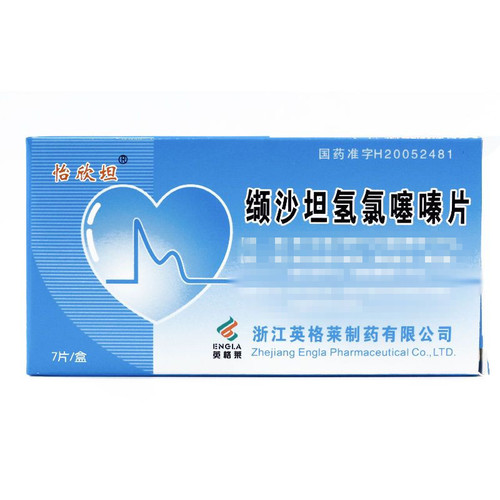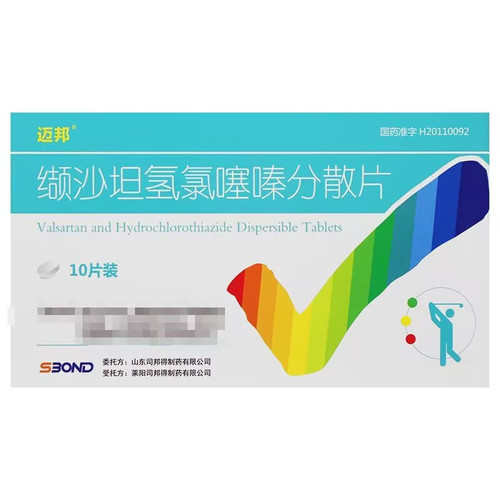Product Overview
[Drug Name]
Generic Name: Valsartan and Hydrochlorothiazide Tablets
Trade Name: Futan
English Name: Valsartan and Hydrochlorothiazide Tablets
Chinese Pinyin: Xiashatan Qinglvsaiqin Pian
[Ingredients]
This product is a combination preparation. Each tablet contains 80 mg of valsartan and 12.5 mg of hydrochlorothiazide.
[Properties]
This product is a film-coated tablet. After removing the film coating, it appears white or off-white.
[Indications]
For the treatment of mild to moderate essential hypertension where blood pressure cannot be adequately controlled with a single medication. This product is not suitable for the initial treatment of hypertension.
[Dosage and Administration]
Oral administration: 1 tablet once daily. Maximum antihypertensive effect is achieved within 2 to 4 weeks of administration. This product can be taken regardless of mealtimes. No dose adjustment is required for patients with mild to moderate renal failure (creatinine clearance ≥ 30 ml/min) or mild to moderate hepatic failure.
[Adverse Reactions]
In two controlled clinical trials involving a total of 1,570 patients, 730 of whom received valsartan in combination with hydrochlorothiazide, the following adverse events were reported: Central Nervous System Common (>5%): Headache (10.8% vs. placebo: 17.2%), dizziness. Uncommon (5-0.1%): Fatigue, depression. Upper Respiratory Tract Uncommon (5-0.1%): Cough, rhinitis, sinusitis, pharyngitis, upper respiratory tract infection, epistaxis. Gastrointestinal Tract Uncommon (5-0.1%): Nausea, diarrhea, dyspepsia, abdominal pain. Lower Urinary Tract Uncommon (5-0.1%): Frequent urination, urinary tract infection. Musculoskeletal System Uncommon (5-0.1%): Arm or leg pain, arthritis, myalgia, sprains and strains, muscle spasms. Other Uncommon (5-0.1%): Asthenia, chest pain, weakness, viral infection, visual disturbances, conjunctivitis. Since the product's introduction to the market, rare reports have occurred, including angioedema, pruritus, and other allergic reactions such as serum sickness and vasculitis. Laboratory tests revealed a decrease in serum potassium greater than 20% in 5.8% of patients treated with the same product, compared to 3.3% of patients receiving placebo. The following adverse events are associated with valsartan alone and not with this product. In rare cases, valsartan can cause decreases in hemoglobin and hematocrit. In controlled clinical trials, significant decreases (>20%) in hemoglobin and hematocrit occurred in 0.8% and 0.4% of patients treated with valsartan, respectively, compared to 0.1% in the placebo group. In controlled clinical trials, the incidence of neutropenia in the valsartan and ACE inhibitor groups was 1.9% and 1.6%, respectively. Significant increases in serum creatinine, potassium, and total bilirubin were observed in 0.8%, 4.4%, and 6% of patients treated with valsartan, respectively, compared to 1.6%, 6.4%, and 12.9% of patients treated with ACE inhibitors, respectively. Elevated liver function tests have been observed occasionally. For patients with essential hypertension receiving valsartan, no specific laboratory monitoring is required. Other adverse reactions reported in valsartan clinical trials include: rare (5-0.1%): arthralgia, gastroenteritis, and neuralgia. There has been only one case of angioedema reported. A causal relationship with valsartan treatment has not been demonstrated. The following adverse reactions have been reported in patients receiving monotherapy with thiazide diuretics (including hydrochlorothiazide), most of whom were taking doses higher than those used in this product: electrolyte and metabolic disturbances.
[Contraindications]
Hypersensitivity to any component of this product or to sulfonamide derivatives. Pregnancy (see [Use in Pregnant and Lactating Women]); severe liver failure, biliary cirrhosis, or cholestasis. Severe renal failure (creatinine clearance 30 ml/min) or anuria. Refractory hypokalemia, hyponatremia, or hypercalcemia, and symptomatic hyperuricemia (history of gout or uric acid stones).
[Precautions]
Serum Electrolyte Changes: Caution is advised when using this medication with potassium-sparing diuretics, potassium supplements, potassium-containing salt substitutes, or other medications that increase serum potassium levels (e.g., heparin). Therefore, serum potassium levels should be monitored regularly. Thiazide diuretics are associated with hyponatremia and hypochloremic alkalosis. Thiazides can cause hypomagnesemia by increasing renal magnesium excretion. Sodium and/or Volume Depletion: Rarely, symptomatic hypotension may occur when initiating treatment with this medication in patients with severe sodium and/or volume depletion (e.g., high-dose diuretic use). Hyponatremia and/or volume depletion should be corrected before initiating treatment with this medication. If hypotension occurs, the patient should be placed supine and, if necessary, given normal saline. Treatment can be resumed after blood pressure stabilizes. Renal Artery Stenosis: There is no experience with this medication in patients with unilateral or bilateral renal artery stenosis or isolated stenosis. Renal Insufficiency: No dose adjustment is required for patients with a creatinine clearance ≥30 mL/min. Hepatic Impairment: This drug should be used with caution in patients with mild to moderate non-cholestatic hepatic impairment. However, since the daily dose of 80 mg valsartan does not exceed the recommended limit and the pharmacokinetics of hydrochlorothiazide are not significantly affected by hepatic impairment, no dose adjustment is required in such patients. Systemic Lupus Erythematosus: Thiazide diuretics can trigger or exacerbate systemic lupus erythematosus. Other Metabolic Disorders: Thiazide diuretics can impair glucose tolerance and increase serum cholesterol, triglyceride, and uric acid levels. Effects on Ability to Drive and Use Machines: As with other antihypertensive drugs, patients taking this drug should exercise caution when driving and using machinery.
[Special Use]
Precautions in Pediatrics:
Insufficient data exist regarding the therapeutic use of this drug in children.
Precautions During Pregnancy and Lactation: Contraindicated in pregnant women.
Precautions in the Elderly: Not known.
[Drug Interactions]
Concomitant use with other antihypertensive drugs may enhance the antihypertensive efficacy of this drug. Caution and monitoring of serum potassium levels are recommended when coadministering valsartan with potassium-sparing diuretics, potassium supplements, potassium-containing salt substitutes, or other medications that increase serum potassium (e.g., heparin). Concomitant use of lithium, ACE inhibitors, and/or thiazide diuretics has been reported to cause reversible increases in serum potassium concentrations and lithium toxicity. There is no experience with the concomitant use of valsartan and lithium. Therefore, regular monitoring of serum lithium levels is recommended when lithium and valsartan are coadministered. No clinically significant interactions have been observed between valsartan and any of the following medications: cimetidine, warfarin, furosemide, digoxin, atenolol, indomethacin, hydrochlorothiazide, amlodipine, and glyburide. Because valsartan contains a thiazide diuretic component, the following interactions may occur: Concomitant use with nonsteroidal anti-inflammatory drugs (e.g., salicylic acid derivatives, indomethacin) may reduce the diuretic and antihypertensive activity of the thiazide component of valsartan. Concomitant volume depletion may lead to acute renal failure. Concomitant use of potassium-wasting diuretics (e.g., furosemide), corticosteroids, adrenocorticotropic hormone (ACTH), amphotericin B, carbenoxolone, penicillin G, or salicylate derivatives can exacerbate potassium and/or magnesium depletion. Hypokalemia or hypomagnesemia caused by thiazides can increase the risk of arrhythmias in patients taking cardiac glycosides. Thiazide diuretics enhance the effects of curare-like muscle relaxants. Adjustment of insulin or oral antidiabetic medication doses may be necessary. Concomitant use of thiazide diuretics may increase the incidence of hypersensitivity reactions to allopurinol. The risk of adverse reactions caused by amantadine may be increased. Thiazides may also potentiate the hyperglycemic effects of diazoxide. Thiazides may reduce the renal excretion of cytotoxic drugs (e.g., cyclophosphamide, methotrexate), thereby increasing their myelosuppressive effects. The bioavailability of thiazide diuretics may be increased when anticholinergic drugs (e.g., atropine, biperiden) are coadministered, possibly as a result of decreased gastrointestinal motility and slower gastric emptying. There have been isolated reports of hemolytic anemia associated with the combined use of hydrochlorothiazide and methyldopa. Cholestyramine and colestipol reduce the absorption of thiazide diuretics. The combined use of thiazide diuretics with vitamin D or calcium salts can enhance the effect of increasing serum calcium. The combined use of cyclosporine may increase the risk of hyperuricemia and cause gout symptoms.
[Pharmacological Actions]
Pharmacological Actions: Valsartan Angiotensin I is converted to angiotensin I (AGII) by angiotensin-converting enzyme (ACE). AGII is a key active component of the renin-angiotensin-aldosterone system (RAAS). It binds to specific receptors on the cell membranes of various tissues and exerts a wide range of physiological effects, including direct and indirect involvement in blood pressure regulation. Angiotensin II is a potent vasoconstrictor that exerts a direct pressor effect, promotes sodium reabsorption, and stimulates aldosterone secretion. Valsartan is an orally effective specific angiotensin (AT) II receptor antagonist that selectively acts on the AT1 receptor subtype, with an affinity for the AT1 receptor 20,000 times stronger than that for the AT2 receptor. The AT1 receptor subtype mediates the physiological response of angiotensin I, and the AT2 receptor subtype is not related to cardiovascular effects. Valsartan has no partial agonist activity on the AT1 receptor. Valsartan does not inhibit ACE (also known as kininase II, which converts angiotensin I into angiotensin II and degrades bradykinin. Valsartan has no inhibitory effect on ACE and does not cause the retention of bradykinin and substance P, so it is not easy to cause cough. Clinical trials comparing valsartan with ACE inhibitors confirmed that the incidence of dry cough in the valsartan group (2.6%) was significantly lower than that in the ACE inhibitor group (7.9%) (P<0.05). In a clinical trial of patients who had developed dry cough symptoms after receiving ACE inhibitor treatment, the valsartan group, Cough was reported in 19.5% of patients in the diuretic group, 19.0% in the ACEI group, and 68.5% in the ACEI group (P < 0.05).
2 In clinical trials, the incidence of cough in patients treated with valsartan and hydrochlorothiazide was 2.9%.
[Storage] Store in sealed containers.
[Specifications] Each tablet contains 80 mg of valsartan and 12.5 mg of hydrochlorothiazide.
[Packaging] 7 tablets/box.
[Expiry Date] 24 months.
[Approval Number] National Medicine Standard H20050429
[Manufacturer] Company Name: Shaanxi Bailu Pharmaceutical Co., Ltd.







